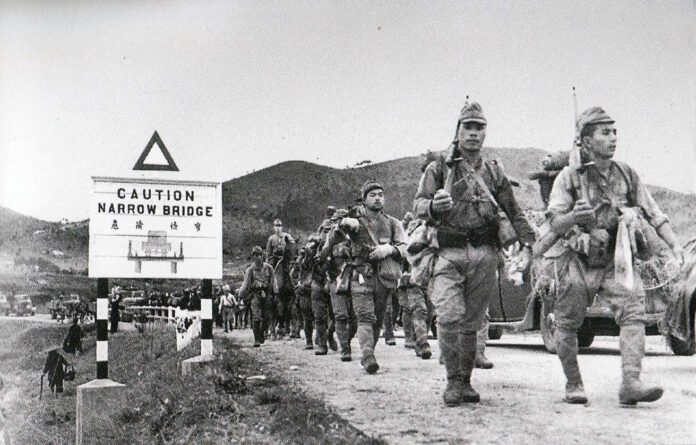
Hong Kong, often referred to as the Pearl of the Orient, experienced a devastating blow during World War II when Japanese forces occupied the city in a mere 18 days. This rapid collapse raises a perplexing question: why did a colony that had been under British administration and development for nearly a hundred years fall so swiftly to the Japanese army? Understanding this requires a close examination of the strategic, diplomatic, and military factors that converged in December 1941 to produce one of the shortest and most decisive campaigns in the Pacific theater.
The roots of Hong Kong’s vulnerability can be traced back to the early 20th century and the diplomatic agreements that constrained British military expansion in the region. The most consequential of these was the Five-Power Naval Treaty, signed in 1922 by the United States, Britain, France, Japan, and Italy. One of the treaty’s key provisions prohibited the construction of new naval bases or fortifications by Britain in its Pacific territories east of the 110th meridian, which included Hong Kong. This clause severely restricted British military flexibility.
Prior to the treaty, Britain had full autonomy over its colonial defenses and could develop Hong Kong’s military infrastructure according to its own strategic priorities. After the treaty, however, Britain was compelled to respect the new balance of naval power in the Pacific, effectively halting any significant expansion or modernization of Hong Kong’s defenses. As Japan rapidly militarized and expanded its sphere of influence across East Asia in the 1930s, Hong Kong remained effectively frozen in time, its fortifications outdated, and its defense plans increasingly obsolete.
While Britain was constrained diplomatically and militarily, Japan prepared meticulously for war. Long before launching their attack, the Japanese military began shaping the battlefield through strategic and covert measures. In early 1939, Japan occupied Hainan Island, completing the encirclement of Hong Kong from the south. This move allowed Japanese forces to establish a strong forward position, from which they could launch attacks or disrupt British supply lines. At the same time, Japanese bombers targeted nearby areas such as Zhuhai and Shenzhen, weakening regional resistance and psychologically pressuring the British.
In addition to military positioning, the Japanese undertook extensive covert operations within Hong Kong itself. Japanese intelligence agencies quietly set up a network of spies and informants throughout the city, many of whom were recruited from local secret societies and triads. These collaborators facilitated the smuggling of weapons, sabotaged British infrastructure, and spread disinformation. This internal subversion not only weakened British authority from within but also gave the Japanese detailed knowledge of British troop deployments, fortification positions, and vulnerabilities. By the time the invasion began, the Japanese military had a remarkably detailed map of Hong Kong’s defense network.
Japan’s military planning was equally comprehensive. As early as December 1939, the Japanese General Staff had formulated a complete operational plan for the invasion of Hong Kong. This plan called for the Japanese Air Force to first destroy British air and naval assets in the territory, after which the Japanese 23rd Army and its 38th Division would launch a ground assault from the Peninsula Kowloon. The plan also included contingencies for cutting off Hong Kong’s water supply and isolating the colony to prevent reinforcements or resupply. Every aspect of the assault was carefully thought out, including how to handle local resistance and how to use air superiority to dominate the battle from the outset.
In contrast, British preparations were slow, limited, and often reactionary. Although British authorities were aware of Japan’s growing threat, their strategic posture toward Hong Kong remained ambivalent. Diplomatic pressure from China led Britain to begin modest defensive improvements in 1939, including the recruitment of local Hong Kong residents into volunteer defense units. Aerial reconnaissance missions over Japanese positions in places such as Humen and the Wanshan Archipelago were initiated in late 1940. Still, the overall approach lacked urgency and seriousness. British command remained focused on Europe, particularly with the looming threat of Nazi Germany. Hong Kong, geographically isolated and politically peripheral in British strategic calculations, was treated more as a symbolic possession than a fortress to be defended at all costs.
This attitude was evident in Britain’s operational goals for Hong Kong, which were not centered on defending the city outright, but rather on denying its use to the Japanese. The British military’s official position was to prevent the Japanese from using Hong Kong’s harbor as much as possible. This passive and limited objective reflected the deeper strategic ambiguity in London. Unlike the Soviet Union’s fanatical defense of Stalingrad, where soldiers and civilians were ordered to fight to the last man, Britain’s plan for Hong Kong was based on an acceptance of eventual defeat. British forces were expected to hold out as long as possible, perhaps to buy time or slow down Japanese advances, but there was no serious expectation of ultimate victory.
Despite these limitations, when war broke out, Japan committed overwhelming force to ensure the success of its invasion. While on other fronts, such as in China, the Japanese army often relied on technological superiority rather than numerical advantage, in Hong Kong they deployed both. Nearly all the Japanese 38th Division was committed to the battle, supported by substantial elements of the 23rd Army. Naval forces included the 2nd China Fleet, as well as special base units stationed in Guangdong and Xiamen. These forces brought with them a formidable array of warships, including a light cruiser, multiple destroyers, gunboats, torpedo boats, and over 300 marines. Japan’s air power was equally strong, featuring dozens of bombers, fighter aircraft, and reconnaissance planes. Perhaps most decisively, the Japanese army deployed eight large caliber 240mm howitzers, which provided devastating artillery support during the assault.
The British garrison in Hong Kong, by comparison, was modest. Totaling just over 14,000 troops, the force was composed of approximately 2,600 British regulars, 3,350 Indian soldiers, 750 Chinese troops, and over 1,700 local volunteers. The British naval presence was comparable in number to Japan’s but lacked modern vessels and support infrastructure. The air force in Hong Kong was particularly underwhelming, consisting mostly of outdated or repurposed civilian seaplanes with limited combat capability. In short, the defenders were outnumbered, outgunned, and already compromised by enemy intelligence.
The battle began on December 8, 1941, one day after the attack on Pearl Harbor. Japanese aircraft swiftly gained air superiority by destroying British air defenses. The Japanese 38th Division launched a coordinated attack on Kowloon under the cover of heavy artillery fire. Although British and volunteer forces resisted bravely, the defenses crumbled after five days of intense fighting. Kowloon was fully occupied by December 13. With the mainland portion of the colony secured, the Japanese turned their attention to Hong Kong Island.
On December 18, the Japanese executed a landing operation. Employing a strategic deception, they staged a feint in the south of the island to divert British forces, while the actual landing occurred in the north, in areas such as North Point and Taikoo, which were poorly defended. Although Indian troops and British tanks mounted a counterattack, Japanese forces quickly overwhelmed the defenders and established a beachhead. The British responded by shelling landing areas and sinking some Japanese transport vessels, temporarily slowing their advance. However, the Japanese troops already ashore pressed forward and captured key command centers, dealing a serious blow to British coordination.
From December 20 onward, the British conducted a determined defense across more than 140 fortified positions. Despite the unclear and defeatist tone from high command, individual officers and troops fought with remarkable courage. Fierce battles erupted in various districts of Hong Kong Island, resulting in heavy casualties on both sides. Nonetheless, the Japanese gradually advanced, exploiting their artillery, air power, and control of local infrastructure. With no prospect of reinforcement, and with water and ammunition supplies dwindling, the defenders’ situation became increasingly hopeless. On December 25, 1941—now known as Black Christmas—the British formally surrendered.
It is worth emphasizing that, despite the strategic disadvantages and lack of preparation, British and local forces managed to inflict over 2,000 casualties on the Japanese. This speaks to the fighting spirit and resilience of the defenders. However, had Britain approached the defense of Hong Kong with the same seriousness as it did during the Battle of Britain, the outcome might have been very different. If the restrictions of the Five-Power Naval Treaty had been challenged or ignored, if modern fortifications had been constructed in time, if a detailed combat plan had been established well in advance, and if the Royal Navy had made efforts to reinforce and resupply the garrison during the battle, Hong Kong might not have fallen so quickly—or at all.
In the end, Hong Kong’s rapid fall was the result of diplomatic constraints, strategic neglect, superior Japanese planning, and overwhelming force. The 18-day campaign was not simply a testament to Japanese strength, but also a reflection of British hesitation, underestimation, and a defensive doctrine shaped more by politics than by the realities of war.
Source: CGTN, Guancha, South China Morning Post



